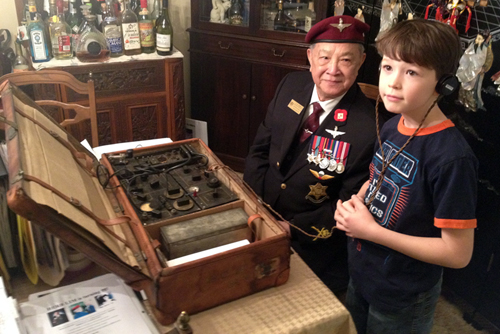
In World War II, Allied secret agents operating in enemy occupied countries, needed to be able to communicate with headquarters This could be tp, request weapons and supplies, to receive instructions, to request evacuation, to provide intelligence on the enemy’s activities etc. Using a radio where one could talk would require much more power and would weigh much more, so the solution was to use Morse Code.
The enemy could also hear messages so agents would encode their messages. To avoid being discovered, these radios were hidden. Broadcasts were kept very short to reduce the risk of the enemy’s detection equipment locating them.
The B2 set in my collection, shown here, was used in France in World War II.
Wireless Set, Type 3 Mark II (“B2” ) Suitcase transceiver. “MODEL 3/II SERIAL No. 91040” Transmitter unit; Receiver unit and Power Supply. Special Operations Executive. (Type used by S.O.,E. and M.I. 9 Escape Organization) Note that the serial numbers were exaggerated by S.O.,E. to disguise the true quantity from the Axis forces and Japanese. This set came in an old wooden carry case which is how it was in WWII. It is now housed in a circa 1930s leather suitcase that obviously had been used in Europe. These were use with Morse code, and messages were encoded. These sets did not use voice. Came with Biley Crystal SN R40920 (round, silver colour)
The “B2” was invented by John Brown (1917-1993) a British Army signals officer. He invented the Biscuit Tin radio, Type 3 Mark II (B2) and Type A Mk. III suitcase radio.
HISTORY:
This “B2” set was used in France during World War II. The French owner hid it behind a wall. The black wooden case resembles a photograph case. I, Colin Stevens, purchased this “B2” set from Dennis Yates in the UK in 2013. He wrote to Colin Stevens: “I bought the set from an old radio amateur who found it in France in the 1950’s and he told me that it was in the case concealed under a radio panel so it was obviously supplied like that which as you know was quite a common thing to do in order to disguise their true identity from the Abwehr. … spares but they do turn up on eBay from time to time” “I started collecting spy sets back in the 1960’s when they were only a few pounds each and over the intervening years have owned more than 100, most of which were acquired in Slovenia from Toni Stipanic who was the chairman of the Yugoslavian Radio Society and an ex Tito partisan. I bought many Polish, German and British sets from him which had been “used in anger” and many of these were used as illustrations in Muelstee’s WFTW Vol. 4 in which I am also acknowledged.” Colin asked “What is a “radio panel”? — Dennis replied: “A radio panel was a hiding place used in ‘Safe Houses’ to conceal radio equipment by the French resistance.” Colin asked: “Do you remember the name and call letters of the old Ham who had it?” Dennis replied: “His call sign was G3EKX and his name was Norman Birkett, he used to have an amateur radio shop on a place called ‘The Spot’ which is on Osmaston Road in Derby.” Colin Stevens bought a c.1930s vintage leather suitcase which is very similar to those used for the B2 sets. It has old hotel stickers for Italy.
I had a very good friend who was a Force 136, S.O.,E. operator. Herb Lim was a Canadian from British Columbia and was trained in India. He excelled at his parachute training etc. and due to this, he was held back from rushing into operations in Malaya to be trained as a wireless operator. He had two big disappointments. One, that because the atomic bombs were dropped, he did not get into action. Two, the Commission as an Officer that he had been promised by the recruiting British officer never came through. I took this set over for Herb to play with and he explained how to operate it to my Grandson and me. Herb still had his notebook from his wireless operator’s classes.